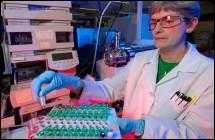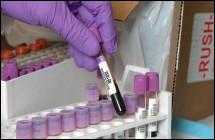Chemical Threat Agents
 CDC's Division of Laboratory Sciences (DLS) and National Biomonitoring Program (NBP) provide effective laboratory support for the public health response to chemical threat agents and threats involving selected toxins.
CDC's Division of Laboratory Sciences (DLS) and National Biomonitoring Program (NBP) provide effective laboratory support for the public health response to chemical threat agents and threats involving selected toxins.
Chemical threat agents can be poisonous vapors, aerosols, liquids or solids that have toxic effects on people. These chemicals can be naturally occurring in the environment or synthetically produced. Chemical releases can be unintentional, as in the case of an industrial accident, or intentional, as in the case of a terrorist attack. Early detection and accurate identification are critical to enable effective treatment and to prevent additional exposures of chemical threats.
Rapid Toxic Screen
The CDC laboratory developed and performs the Rapid Toxic Screen (RTS), a series of tests that analyzes 150 chemical agents in people's blood and urine. Results of the Rapid Toxic Screen help identify which chemicals were used, who was exposed to the chemicals, and how much of a particular chemical their bodies absorbed. This information is critical to medical and public health personnel managing a chemical public health emergency.
Chemical Emergency Response Team
CDC maintains 24-7 laboratory response capability and can deploy the Chemical Emergency Response Team within two hours of a request to assist with specimen collection, packaging, storage, and shipment. DLS scientists work with state and local officials to collect samples and transport them to CDC where testing can be done to assess people's exposure to chemical agents. Within 24 hours of arrival in the lab, using the Rapid Toxic Screen, the chemical agent of concern can be identified. Within 36 hours, up to 40 samples can be tested and results reported to decision makers.
Laboratory Response Network for Chemical Threats (LRN-C)
 CDC sponsored the creation of the Laboratory Response Network-Chemical (LRN-C), a national network for responding to chemical terrorism and other public health emergencies. LRN-C integrates 55 state and local public health laboratories that operate 24/7 to provide laboratory diagnostics and the surge capacity for chemical emergencies.
CDC sponsored the creation of the Laboratory Response Network-Chemical (LRN-C), a national network for responding to chemical terrorism and other public health emergencies. LRN-C integrates 55 state and local public health laboratories that operate 24/7 to provide laboratory diagnostics and the surge capacity for chemical emergencies.
As a critical partner, CDC's Chemical Emergency Response Laboratories provide the LRN-C with a wide range of support services, including:
- Standardized reagents and controls
- Agent-specific protocols
- Lab referral directory
- Secure communications
- Electronic messaging
- Training and technology transfer
- Proficiency testing
- Training and Full Scale exercises
Additional Resources
Get email updates
To receive email updates about this page, enter your email address:
Contact Us:
- Centers for Disease Control and Prevention
1600 Clifton Rd
Atlanta, GA 30333 - 800-CDC-INFO
(800-232-4636)
TTY: (888) 232-6348 - New Hours of Operation
8am-8pm ET/Monday-Friday
Closed Holidays - Contact CDC-INFO


